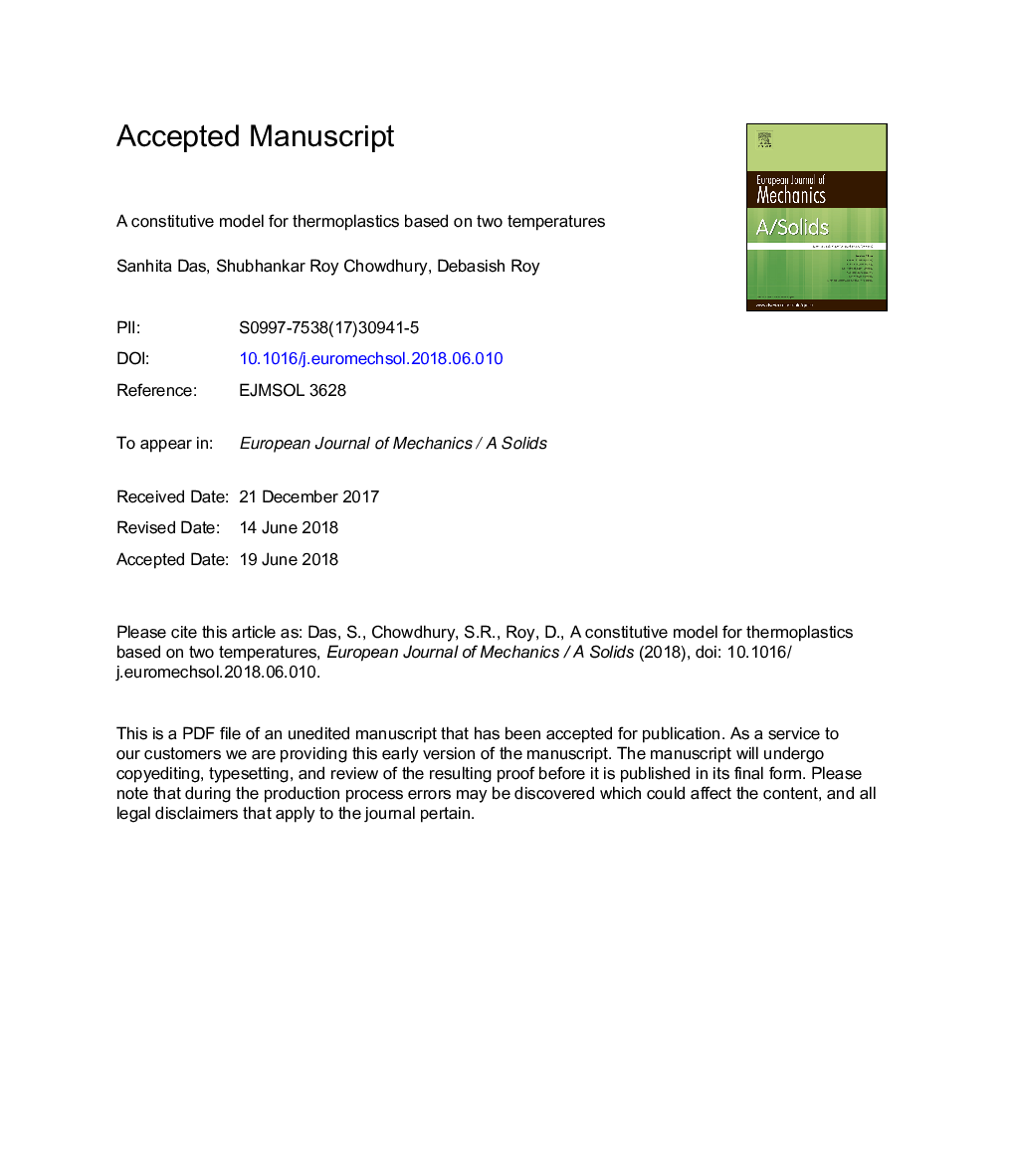| کد مقاله | کد نشریه | سال انتشار | مقاله انگلیسی | نسخه تمام متن |
|---|---|---|---|---|
| 7170086 | 1463175 | 2018 | 38 صفحه PDF | دانلود رایگان |
عنوان انگلیسی مقاله ISI
A constitutive model for thermoplastics based on two temperatures
ترجمه فارسی عنوان
یک مدل سازنده برای گرمانرم بر پایه دو درجه حرارت است
دانلود مقاله + سفارش ترجمه
دانلود مقاله ISI انگلیسی
رایگان برای ایرانیان
کلمات کلیدی
ترجمه چکیده
در چارچوب ترمودینامیکی دو درجه حرارت قرار می گیریم، هدف ما پیشنهاد یک مدل سازگار با الیاف شیشه ای یکپارچه برای پلیمرهای ترموپلاستی ساده ترولوژیکی است. این مدل سازی مدل معمولا در مورد پدیده هایی است که در آن فرآیندهای فراماسونیکی با مقیاس زمانی مختلف رخ می دهند و بنابراین سیستم ترمودینامیکی ممکن است به صورت متشکل از دو زیر سیستم تفسیر شود. زیرسیستم پیکربندی حاوی حالت های کندتر است، در حالی که زیر سیستم جنبشی-ارتعاشی شامل حالت های سریعتر حرکت می کند. این دو زیرسیستم به دلیل کم بودن سرعت آرام سازی ساختارها در زمان آزمایش آزمایشگاهی در حالت شیشه ای (درجه حرارت پایین یا شدت بالا) تعادل ندارند. همانطور که گذار به رژیم لاستیک در دمای بالاتر از انتقال شیشه یا در سرعت بارگذاری کم، شروع می شود، دو زیر سیستم در محدوده میکروسکوپی تعادل می یابد. این مدل به واسطه مکانیزم های مختلف زیربنایی، نسخه های الهام گرفته شده از انرژی های آزاد را به صورت فیزیکی مورد استفاده قرار می دهد. کشش الاستیک، تحولات برشی موضعی و راست زدن درون مولکولی زنجیره ای. یک فرمول ساده وابسته به دما برای آرام سازی ساختاری از لحاظ انتقال حرارت بین زیرسیستم ها برای تسریع انتقال بین این مکانیسم ها استفاده می شود. سپس مدل در برابر نتایج آزمایشی آزمون فشرده سازی یکسانی برای نرخ های مختلف فشار و درجه حرارت تأیید می شود و توانایی آن را برای انتقال یکپارچه بین رژیم های شیشه ای و رطوبت فراهم می کند. همچنین اثربخشی مدل در جذب ویژگی های کلیدی پیری فیزیکی و جوان سازی مکانیکی نشان داده شده است.
موضوعات مرتبط
مهندسی و علوم پایه
سایر رشته های مهندسی
مهندسی مکانیک
چکیده انگلیسی
Posed within a two-temperature thermodynamic framework, our aim is to propose a unified glass-rubber constitutive model for thermo-rheologically simple thermoplastic polymers. This modelling set-up usually applies to phenomena wherein sub-macroscopic processes involving different time scales occur and accordingly the thermodynamic system may be interpreted as comprising of two subsystems. The configurational subsystem contains the slower states, while the kinetic-vibrational subsystem comprises of the faster moving states. The two subsystems fail to equilibrate within experimental timescales in the glassy regime (low temperature or high strain rate) due to low structural relaxation rates. As transition to the rubbery regime commences at temperatures higher than glass transition or at sufficiently low loading rates, the two subsystems equilibrate within microscopic timescales. The model exploits physically inspired prescriptions for the free energies due to different underlying mechanisms - elastic stretching, localised shear transformations and intra-molecular straightening of chains. A simple temperature dependent formulation for structural relaxation in terms of heat transfer between the subsystems is used to capture transition between these mechanisms. The model is then validated against experimental results of uniaxial compression tests for various strain rates and temperatures establishing its ability to seamlessly transit between the glassy and rubbery regimes. Also demonstrated is the model's efficacy in capturing the key features of physical ageing and mechanical rejuvenation.
ناشر
Database: Elsevier - ScienceDirect (ساینس دایرکت)
Journal: European Journal of Mechanics - A/Solids - Volume 72, NovemberâDecember 2018, Pages 440-451
Journal: European Journal of Mechanics - A/Solids - Volume 72, NovemberâDecember 2018, Pages 440-451
نویسندگان
Sanhita Das, Shubhankar Roy Chowdhury, Debasish Roy,
